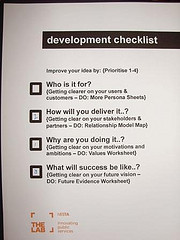Save yourself time, energy and stress with custom checklists for your home office
Recently I had the oil changed in my car. During the procedure one guy was shouting out check points to the guy in the pit under my car. While is seemed a bit noisy, I knew with their check system there was no risk of my driving away without oil in my engine. I observed this system after I sent an article to an e-zine – and right after I hit the “send” button, I remembered I forgot to finish the article with a “call to action” or action steps. Doh! My book The Smarter Home Officehas “highlights”/action steps at the end of each chapter and a big check list at the end of the book, so I know better. 
A best selling book: The
Checklist Manifesto: How to Get Things Right by Atul Gawande. He states that mistakes can be prevented when people have the right knowledge at hand and apply the knowledge correctly. The hard part is remembering all that knowledge and it applications. This is were checklists come in – designed well and used appropriately they prevent mistakes, from the merely inconvenient to the tragic, in much of what we do. Most people have a standard pre-written packing list for when they travel. That way you know you have not left your prescription meds behind, or your reservation confirmations. Pilots must perform a pre-flight checklist before they taxi away from the jetway. Rather than trust preparing the lasagna to your memory, you use a recipe, because one missing ingredient or step can mean a bad meal.
How about checklists for the home office? If you do something routinely, wouldn’t it be nice to have a list or step-by-step procedure outline to be sure you didn’t forget something important? When you bill your clients do you have a list of all the necessary details that need to go into that bill or invoice? Have check lists for: pre-presentation packing list, the steps to publishing a blog post (I’m working on my own right now), the items to be included in an invoice or bill – hours worked, materials, mileage, postage, etc.; all listed so you don’t have to re-invent the wheel every time.
You could have your checklists stored in a folder on your computer, either with the data you need for that task, or in a designated folder for checklists. Then before you start working on your project you pull up the list, quickly review it and then minimize it on your screen. Work on your task and check on the list as you go along. No need to second guess yourself. Changing or updating the checklists is easy.
An effective checklist includes:
- A clearly-stated objective for the check list
- It fits on one page
- Each step is actionable
- It is written clearly, without ambiguity.
- Lists one action per item
- There are naturally-placed rest points
- There are 10 items or less between rest points
- Fits the flow of work
- Errors can be picked up while there is still time to correct them
“Man is fallible, but many men are less so.”
Get feedback from friends, team members and colleagues who have a special skill or can offer a fresh and informed set of eyes to your checklist.
Pick a routine task that has a lot of necessary details. Jot down notes about what you need to do and when to complete the project to your standards, while you are doing the task. Then arrange your notes into a checklist or protocol to guide you with this task in the future.
Photo by Peter Ashe